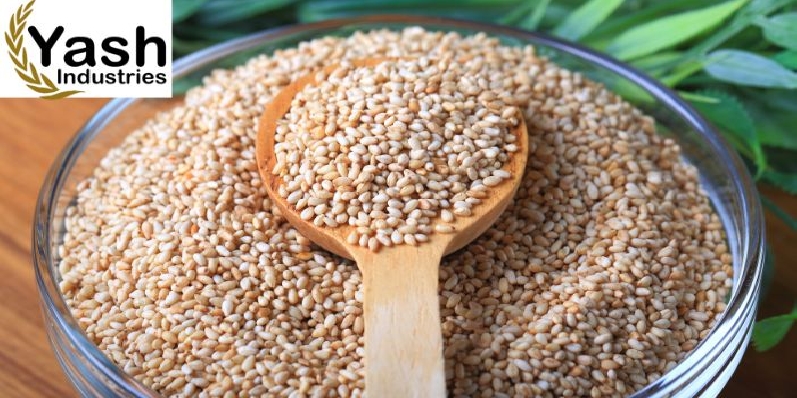
29-03-2024
The Culinary Treasure of Kitchen:- Sesame Seeds Price
- Admin
Step into any kitchen around the globe, and you're likely to find a jar of sesame seeds price among the spices and condiments. These tiny seeds, packed with flavor and nutritional goodness, have earned their place as a culinary staple in cuisines ranging from Asian to Middle Eastern to Mediterranean. However, behind their ubiquity lies a complex interplay of factors that influence the market prices of sesame seeds. In this blog, we'll explore the journey of sesame seeds from field to kitchen, unraveling the dynamics that shape their prices and their significance in the culinary world.
The Essence of Sesame Seeds Pricein Culinary Delights - Sesame Seeds Price
Sesame seeds price, derived from the flowering sesame plant, have been a part of human diets for thousands of years. Their nutty flavor and delicate crunch add depth and texture to a wide array of dishes, from salads and stir-fries to baked goods and desserts. Whether sprinkled on top of a bagel, incorporated into a savory sauce, or ground into a creamy tahini paste, sesame seeds lend a distinctive taste and aroma that elevate culinary creations to new heights, sesame seeds price.
Nutritional Benefits and Growing Demand - Sesame Seeds Price
Beyond their culinary allure, sesame seeds boast an impressive nutritional profile, making them a sought-after ingredient in health-conscious kitchens. Rich in protein, fiber, vitamins, minerals, and antioxidants, sesame seeds price offer a host of health benefits, including improved heart health, bone density, and immune function. As consumers become increasingly mindful of their dietary choices, the demand for nutrient-dense ingredients like sesame seeds continues to rise.
Global Production and Supply Chain Dynamics - Sesame Seeds Price
Sesame seeds are predominantly cultivated in regions with warm climates, including Africa, Asia, and Latin America. Within these regions, countries such as India, China, Sudan, and Ethiopia are major producers of sesame seeds price. The cultivation process typically involves planting, nurturing, and harvesting sesame plants, followed by processing and packaging the seeds for distribution.
However, the journey from farm to table is not without its challenges. Factors such as weather fluctuations, pest infestations, and labor shortages can impact crop yields and disrupt supply chains. Additionally, geopolitical tensions, trade policies, and transportation logistics play a role in determining the availability and prices of sesame seeds in global markets.
Price Determinants and Market Trends - Sesame Seeds Price
The market dynamics of sesame seeds price are influenced by a variety of factors, both internal and external to the agricultural sector. Within the sesame seed market, supply and demand dynamics play a pivotal role in shaping prices. Fluctuations in crop yields, driven by climatic conditions and agricultural practices, can affect the overall supply of sesame seeds and contribute to price volatility.
On the demand side, factors such as population growth, dietary trends, and culinary preferences influence the consumption patterns of sesame seeds price. The growing popularity of plant-based diets, for instance, has fueled demand for sesame-based products like tahini, hummus, and sesame oil. Additionally, the expanding global food industry and the rise of international cuisines have created new opportunities for sesame seeds to penetrate diverse markets.
External factors, including macroeconomic conditions, currency exchange rates, and trade agreements, also impact sesame seed prices. Economic instability, inflation, and currency devaluation can affect production costs and purchasing power, leading to fluctuations in input prices and market competitiveness. Moreover, trade tensions and geopolitical conflicts can disrupt supply chains and hinder the flow of sesame seeds across borders.
Navigating Price Volatility and Future Outlook - Sesame Seeds Price
Given the inherent volatility of agricultural markets, stakeholders in the sesame seed industry must adopt strategies to manage risk and adapt to changing conditions. Producers may employ techniques such as crop diversification, crop insurance, and forward contracts to mitigate the impact of price fluctuations and safeguard their livelihoods.
Similarly, traders and manufacturers may utilize hedging instruments, market research, and supply chain optimization strategies to minimize exposure to market risks and capitalize on emerging opportunities. Furthermore, collaboration among industry players, government agencies, and international organizations can foster resilience and sustainability within the sesame seed value chain.
Looking ahead, the future of sesame seeds in the culinary landscape appears promising, driven by evolving consumer preferences, technological advancements, and a growing appreciation for natural, wholesome ingredients. As sesame seeds price continue to weave their way into kitchens around the world, their journey from field to fork will remain a testament to their enduring appeal and culinary versatility.
Conclusion
In conclusion, sesame seeds occupy a central role in the global culinary landscape, cherished for their flavor, nutrition, and culinary versatility. The market prices of sesame seeds are influenced by a myriad of factors, including supply and demand dynamics, production conditions, and external market forces. By understanding the complexities of the sesame seed market and adopting proactive strategies, stakeholders can navigate price volatility and harness the potential of sesame seeds as a culinary treasure trove. Whether sprinkled atop a salad or blended into a creamy sauce, sesame seeds price continue to captivate taste buds and enrich culinary experiences worldwide.